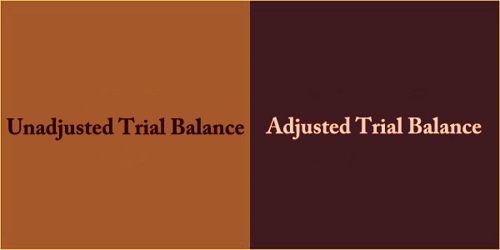Unadjusted Trial Balance –
An unadjusted trial balance is what we get when we calculate account balances for each individual account in our books over a particular period of time. It is a listing of all account balances derived from the respective ledger accounts prior to making any adjustments.
Every business determines the intervals at which it draws up its financial statements. This may be monthly, quarterly or even annually matching with the accounting period. At the end of each period, the ledger accounts are totaled and their balances are summarized in a trial balance. This first trial balance is an unadjusted trial balance.
According to the rules of double-entry accounting, a company’s total debt balance must equal its total credit balance. If the sum of the debit entries in a trial balance doesn’t equal the sum of the credits that means there’s been an error in either the recording of the journal entries. If we use accounting software, this usually means we have made mistake inputting information into the system. Searching for and fixing these errors is called making correcting entries.
The primary purpose of an unadjusted trial balance is to check the arithmetical accuracy of the ledger accounts and to ensure that the books are in balance i.e., a total of debits equals the total of credits. This is an essential step in a double-entry accounting system. Unadjusted trial balance is prepared in columnar format, with debit balances recorded in the left column and credit balances recorded in the right column.
Adjusted Trial Balance –
The adjusted trial balance is what we get when we take all of the adjusting entries from the previous step and apply them to the unadjusted trial balance. It should look exactly like our unadjusted trial balance, save for any deferrals, accruals, missing transaction or tax adjustments we made. It is a trial balance that is prepared after incorporating period-end adjusting journal entries in an unadjusted trial balance.
Adjusting journal entries include adjustments made by accountants of the organization as well by the auditors at the time of the finalization of accounts. These can include:
- Period end accruals such as accrual of rent of the last month, accrual of pending utility bills, etc.
- Prepaid expense allocation of expenses paid for but not pertaining to the current period
- Adjustment for stock discrepancies identified during year-end physical stock take
- Adjustments recommended by auditors to align books with accounting standards or rules
While an adjusted trial balance is also prepared in columnar format, it has additional columns for adjustments. The adjustments can be made directly in the trial balance or bypassing adjusting entries through the respective ledger accounts.
Just like in an unadjusted trial balance, the total debits and credits in an adjusted trial balance must equal. An adjusted trial balance can be prepared several times before finalization to incorporate adjustments at different stages of the account and audit finalization.
Difference between unadjusted trial balance and adjusted trial balance:
In the world of numbers where accounting rules, a trial balance is one tool that is very essential. One error in the journal and the entire ledger will crumble. A trial balance contains all the accounts in the ledger of a certain business. The lists of accounts may contain assets and liabilities as well as revenues and expenses. Accountants are taking necessary precautions to make the two sides maintain their balance otherwise there is an error in the process, and they have to repeat everything they did again.
An adjusted trial balance is one that presents the total listing of all the account balances and titles in the ledger after all the adjustments have been made in a certain period. On the other hand, it is a wise step to always use an unadjusted trial balance especially after every posting of the accounting transactions in a month. This way, errors can be easily detected on both sides between the debit column and the credit column. These two kinds of trial balance are both pertinent to auditors and accountants alike. They are both necessary for the in-balance reporting during the end-of-period processing. But no matter how important their roles are, there are still some differences seen between the adjusted and unadjusted trial balance.
The difference between unadjusted and adjusted trial balance has been detailed below:
Meaning –
- Unadjusted trial balance is the first list of ledger account balances, compiled without making any period-end adjustments.
- The adjusted trial balance is the trial balance compiled after considering adjustment entries at the close of the accounting period.
Hierarchy in accounting cycle –
- Unadjusted trial balance is prepared first after all ledger accounts are totaled and balanced at the period end.
- An adjusted trial balance is prepared after the compilation of the unadjusted trial balance.
Content –
- Unadjusted trial balance does not include adjustment entries.
- The adjusted trial balance includes all adjustment entries.
Purpose –
- Unadjusted trial balance is prepared to check the arithmetical accuracy of ledger accounts and to check that the books of accounts are in balance.
- The adjusted trial balance has a wider purpose of checking the accounting accuracy of the books of accounts. It incorporates adjustments to align the accounting entries with accounting standards and principles.
Accuracy –
- Unadjusted trial balance is a less accurate presentation of account balances than an adjusted trial balance.
- Adjusted trial balance is more accurate as it makes adjustments for all entries that have been recorded but do not pertain to the current period and all entries that have not been recorded but pertain to the current period.
Versions –
- An unadjusted trial balance has the only version prepared once ledger accounts are totaled and balanced.
- An adjusted trial balance can have multiple versions as adjustments may be made at several stages of account and audit finalization.
Format and method of preparation –
- Unadjusted trial balance is prepared in columnar format.
- The adjusted trial balance is also prepared in columnar format but has an additional column for adjustments. These adjustments can be made directly in the trial balance or through the ledger accounts subsequently posted to the adjusted trial balance.
Understanding the trial balance is crucial if we handle our business accounting system manually. But if we had rather leave that work to an expert, consider using a service like Bench.
We cannot shrug off the fact that the purpose of having a trial balance in accounting is truly inevitable. It marks the value of both the debit and the credit. With a trial balance, we are ensured that the reporting is accurate. With the help of both the adjusted and unadjusted type of trial balance, the work of a bookkeeper or an accountant becomes less burdensome.
Information Sources:
















